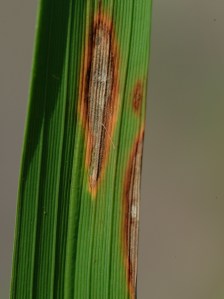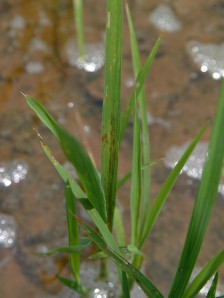These are blast disease lesions on Jupiter, but they could be on any variety. Two points here, blast is present this year and Jupiter is susceptible. To really control blast it will require two fungicide applications. Read the fungicide label to determine the timing depending on which fungicide you use. In general, the first application should be made during boot (approximately 4″ panicle) and then at about 50% heading. That is an expensive treatment.
It is unusual to have bronzing, a symptom of zinc deficiency, show up when it is warm and rice is older. In this case the problem is induced by the high pH of the soils. In the area they are known to be above 8 in many cases. Even though the soil may test high in zinc it is not available because of the pH. We recommended an application of zinc chelate or zinc sulfate to correct the problem.
When the Clearfield system was introduced several years ago we were concerned about possible misapplications of Newpath to conventional rice fields. While there have been a few reported cases of those situations most of the problems have been the result of drift from a Newpath application to Clearfield rice onto a nearby field of conventional rice. The straw colored plants in this picture are already dead.
The plant at right shows typical Newpath injury symptoms. The growing point is killed resulting in a straw colored leaf in the center of the plant. The oldest leaves are still green. This is what we have learned to expect in Newpath drift onto conventional rice.
If a plant like the one in the previous photograph are dissected lenghwise it will reveal dead or dying tissue. The scientific term is necrosis. Plants exhibiting this degree of injury will not recover.
In many instances the dose of Newpath is not enough to cause death of the plant, but the effects can be nearly as severe from a production standpoint. In this case the growing point development is suppressed to the point that several axillary buds are developing. In a normal plant as long as the growing point remains intact these buds never develop. Even if these buds develops stems and eventually heads the heads will be smaller than normal and much later than normal. The plant is competing with itself to produce grain as a survival mechanism.









